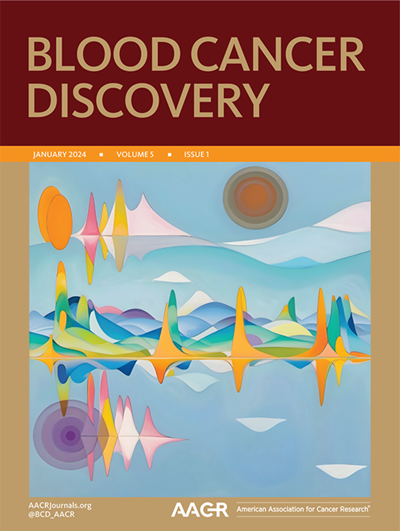摘要A41:单细胞多组分析揭示急性髓细胞白血病中TP53-mut杂合性缺失与原始表型的相关性
IF 11.5
Q1 HEMATOLOGY
引用次数: 0
摘要
急性髓细胞白血病(AML)中的TP53突变与拷贝数异常(CNA)、结构变异和高复发风险有关(Döhner等人,2017;Giacomelli等人,2018;Bernard等人2020)。尽管通过靶向治疗获得了相对较高的缓解率,但TP53突变体(TP53-mut)克隆仍然存在,总是导致复发(Short等人,2021;Takahashi等人,2016)。在AML治疗期间描绘TP53突变克隆的克隆结构和免疫表型可以更好地理解TP53突变在AML生物学中的作用。测序技术的最新进展允许在单细胞水平上整合基因分型和表型。在这里,我们利用MissionBio-Tapestri的最新平台:单细胞DNA+蛋白,在5名TP53-mut AML患者治疗前后的10个配对样本中,用45种表面寡聚缀合抗体同时进行基因分型和表型分型。用TotalSeq对具有至少70%活力的样品进行染色™-D人类血红素肿瘤学鸡尾酒,V1.0。表面标记染色后,根据制造商的说明进行单细胞悬浮、包封和条形码。对于scDNA文库的制备,我们使用了一个经过验证的自定义面板(Morita等人,2020),该面板由279个扩增子组成,覆盖AML中37个基因的复发突变。我们对10个样本中的44550个细胞进行了测序。我们证实了MD Anderson分子诊断实验室在scDNA定制小组覆盖的基因中报告的突变。克隆结构分析区分了具有或不具有正常TP53等位基因杂合性(LOH)缺失的TP53突变克隆。我们的数据显示,与TP53突变LOH-克隆相比,具有LOH(LOH+)克隆的TP53突变具有原始免疫表型。我们发现,与TP53 mut LOH-克隆相比,TP53 mut-LOH+克隆的CD34和CD117的LOG2FC分别增加了2.4和1.8(p<0.001)。克隆进化分析表明,TP53突变LOH+克隆对治疗的抵抗力明显高于TP53突变-LOH-,这与以前的出版物一致。另一方面,与TP53mut-LOH+相比,TP53mut LOH-克隆在其他谱系标记物中显示出显著更高的CD2、CD16、CD5、CD3和CD8水平(LOG2FC分别为1.1、1.2、1.4、1.1和1.1;p值<0.0001)。这些数据表明,TP53突变LOH细胞可以表达淋巴表型标记。单细胞细胞因子分析(IsoPlexis)显示TP53突变AML的T细胞中严重缺乏分泌的细胞因子。将提供来自大量RNA测序、ddPCR和CyTOF的进一步数据,以验证TP53突变LOH-的淋巴表型。总之,我们利用scDNA+蛋白质多组方法来剖析克隆结构,并提供TP53突变AML的基因型-表型之间的联系。我们发现,虽然TP53mut LOH+克隆仅是原始的,但TP53mut-LOH-克隆保留了在原始免疫表型之外存在的能力,并且可能缺乏分化阻断。引文格式:Edward Ayoub、Vakul Mohanty、Yuki Nishida、Tallie Patsilevas、Mahesh Basyal、Russell Pourebrahim、Muharrem Muftuoglu、Ken Chen、Ghayas C.Issa、Michael Andreeff。单细胞多组分析揭示急性髓细胞白血病中TP53-mut杂合性缺失与原始表型的相关性[摘要]。载:AACR特别会议论文集:急性髓细胞白血病和骨髓增生异常综合征;2023年1月23日至25日;德克萨斯州奥斯汀。费城(PA):AACR;血液癌症Discov 2023;4(3_Suppl):摘要编号A41。本文章由计算机程序翻译,如有差异,请以英文原文为准。
Abstract A41: Single Cell Multiomic Analysis Reveals Association of TP53-mut Loss of Heterozygosity with Primitive Phenotype in Acute Myeloid Leukemia
TP53 mutations in acute myeloid leukemia (AML) are associated with copy number abnormalities (CNA), structural variants and high risk of relapse (Döhner et al., 2017; Giacomelli et al., 2018; Bernard et al. 2020). In spite of relatively high remission rates obtained by targeted therapies, TP53 mutant (TP53-mut) clones persist, invariably resulting in relapse (Short et al., 2021; Takahashi et al., 2016). Delineating the clonal architecture and the immunophenotypes of TP53-mut clones during AML therapy may provide a better understanding of the role of TP53-mutations in AML biology. Recent progress in sequencing technologies allows the integration of genotyping and phenotyping at the single cell level. Here, we took advantage of MissionBio Tapestri’s newest platform: single cell DNA + protein for simultaneous genotyping and phenotyping with 45 surface oligo-conjugated antibodies in 10 paired samples from 5 patients with TP53-mut AML before and after therapy. Samples with at least 70% viability were stained with the TotalSeq™-D Human Heme Oncology Cocktail, V1.0. Following surface marker staining, single-cell suspension, encapsulation, and barcoding were performed according to manufacturer’s instruction. For scDNA library preparation, we utilized a validated custom panel (Morita et al. 2020) consisting of 279 amplicons covering recurrent mutations in 37 genes in AML. We sequenced a total of 44,550 cells from 10 samples. We confirmed mutations reported by MD Anderson molecular diagnostic laboratory in the genes covered by the scDNA custom panel. The clonal architecture analysis distinguished between TP53-mut clones with or without loss of heterozygosity (LOH) of the normal TP53 allele. Our data show a primitive immunophenotype in TP53-mut with LOH (LOH+) clones in comparison to TP53-mut LOH- clones. We see 2.4 LOG2FC increase in CD34 and 1.8 LOG2FC increase in CD117 (p<0.001) in TP53-mut LOH+ clones in comparison to TP53-mut LOH- clones. Clonal evolution analysis shows that TP53-mut LOH+ clones are significantly more resistant to therapy than TP53-mut LOH-, consistent with previous publications. On the other hand, TP53-mut LOH- clones showed significantly higher levels of CD2, CD16, CD5, CD3, and CD8 among other lineage markers (LOG2FC= 1.1, 1.2, 1.4, 1.1, and 1.1 respectively; p.value <0.0001) compared to TP53-mut LOH+. This data indicates that TP53-mut LOH- cells can express lymphoid phenotypic markers. Single cell cytokine analysis (IsoPlexis) reveals profound lack of secreted cytokines in T-cells from TP53-mut AML. Further data from bulk-RNA sequencing, ddPCR, and CyTOF will be presented that validates a lymphoid phenotype of TP53-mut LOH-. In summary, we utilize a scDNA+protein multiomic approach to dissect clonal architecture and provide a link between genotype-phenotype in TP53-mut AML. We show that while TP53-mut LOH+ clones are exclusively primitive, TP53-mut LOH- clones retain the capacity to exist outside primitive immunophenotype and might lack differentiation block.
Citation Format: Edward Ayoub, Vakul Mohanty, Yuki Nishida, Tallie Patsilevas, Mahesh Basyal, Russell Pourebrahim, Muharrem Muftuoglu, Ken Chen, Ghayas C. Issa, Michael Andreeff. Single Cell Multiomic Analysis Reveals Association of TP53-mut Loss of Heterozygosity with Primitive Phenotype in Acute Myeloid Leukemia [abstract]. In: Proceedings of the AACR Special Conference: Acute Myeloid Leukemia and Myelodysplastic Syndrome; 2023 Jan 23-25; Austin, TX. Philadelphia (PA): AACR; Blood Cancer Discov 2023;4(3_Suppl):Abstract nr A41.
求助全文
通过发布文献求助,成功后即可免费获取论文全文。
去求助
来源期刊

Blood Cancer Discovery
Multiple-
CiteScore
12.70
自引率
1.80%
发文量
139
期刊介绍:
The journal Blood Cancer Discovery publishes high-quality Research Articles and Briefs that focus on major advances in basic, translational, and clinical research of leukemia, lymphoma, myeloma, and associated diseases. The topics covered include molecular and cellular features of pathogenesis, therapy response and relapse, transcriptional circuits, stem cells, differentiation, microenvironment, metabolism, immunity, mutagenesis, and clonal evolution. These subjects are investigated in both animal disease models and high-dimensional clinical data landscapes.
The journal also welcomes submissions on new pharmacological, biological, and living cell therapies, as well as new diagnostic tools. They are interested in prognostic, diagnostic, and pharmacodynamic biomarkers, and computational and machine learning approaches to personalized medicine. The scope of submissions ranges from preclinical proof of concept to clinical trials and real-world evidence.
Blood Cancer Discovery serves as a forum for diverse ideas that shape future research directions in hematooncology. In addition to Research Articles and Briefs, the journal also publishes Reviews, Perspectives, and Commentaries on topics of broad interest in the field.
 求助内容:
求助内容: 应助结果提醒方式:
应助结果提醒方式:


